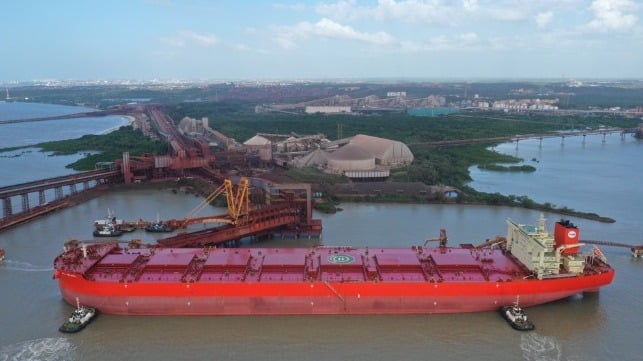Vale Begins Air Lubrication Pilot on First Large Ore Carrier

The first large ore carrier to be outfitted with an air lubrication system for its hull completed its maiden voyage as part of a trial program to explore the fuel-saving benefits of the technology on this class of vessel. The pilot project is the latest in a series of tests Brazilian mining giant Vale is conducting to enhance the operations and environmental performance of its fleet.
The air lubrication system was installed aboard the newly built 324,268 dwt Sea Victoria, a Guaibamax ore carrier. Built for Korean shipowner Pan Ocean by China’s New Times Shipbuilding at the Yiu Lian Dockyards located in Shenzhen, the vessel measures 1,115 feet in length with a 203-foot beam. The Sea Victoria arrived at the Ponta da Madeira Maritime Terminal, in São Luís, Brazil on August 18 and is due to begin its first trip to China.
While the air lubrication technology has been fitted on other classes of ships, including several large cruise ships, it is the first time it has been applied to a VLOCs (Very Large Ore Carrier) and a vessel of this scale. Ten compressors installed beneath the ship's deck send air to 20 devices positioned underneath the ship, which produce a carpet of bubbles. The action reduces the friction between the hull and the water, reducing fuel consumption and, consequently, emissions, which will help Vale to further reduce greenhouse gas (GHG) emissions in navigation.
The installation of the technology, supplied by the English manufacturer Silverstream, is part of a project developed by Vale's navigation area, with the cooperation of the Vale Technological Institute. Vale and the shipbuilder worked with the Shanghai Ship Design Research Institute (SDARI), which was responsible for the ship design and integration of the air lubrication technology. The installation required 35 days.
“Expectations point to a fuel reduction of around 5 to 8 percent per ship,” said Rodrigo Bermelho, technical manager of Vale Shipping. “The technology has the potential to be installed in the entire fleet if it proves successful of the VLOC. In a year, a single vessel would stop emitting up to 5,600 tons of CO2,” Bermelho said explaining that it could represent a 4.4 percent reduction in annual emissions from Vale’s maritime transport of iron ore.
The adoption of air lubrication is part of Ecoshipping, a program created by Vale to meet the challenge of reducing its carbon emissions. Last year, the company announced that it intends to neutralize its direct and indirect emissions in 2050 while initially reducing emissions by 15 percent by 2035.
In addition to the pilot project with air lubrication, Vale is also testing the world's first ore carrier equipped with rotor sails, also built in China. Like air lubrication, the rotors were installed on a Guaibamax. There are five sails distributed along the vessel that is designed to produce an efficiency gain of up to eight percent. If the rotor pilot proves to be efficient, it is estimated that at least 40 percent of the fleet would be to use the technology.
